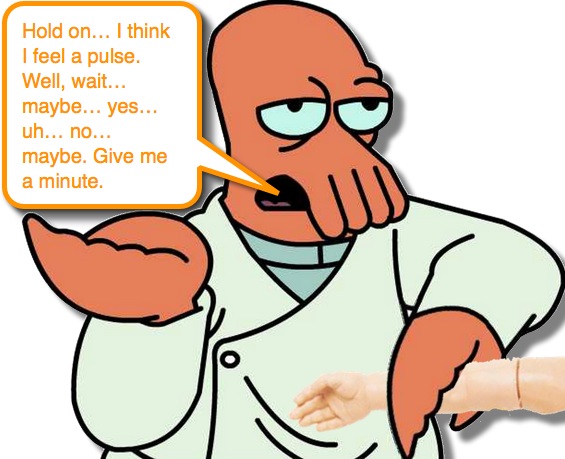Palpation of Pulse for Cardiac Arrest
One of my personal goals is to make my life easier. Yes, that is easier said than done; particularly given my proclivity for working in the Emergency Department. The ED is not an easy place to work many times, particularly when faced with truly life-altering events like a pediatric cardiac arrest. While managing pediatric cardiac arrests is never easy (no matter how clinically skilled you are), the first task of determining whether the child actually does or does not have a pulse would seem to be the easiest. Sadly, it is not.
Phases of Pediatric Cardiac Arrest
- Pre-Arrest
- This is where Injury Prevention has the greatest potential to save lives.
- The Back to Sleep program, Submersion awareness, and trauma prevention are example.
- Also where being vigilant for “covert sickness“ can came in handy (hopefully the Morsels help you with this part).
- This is where Injury Prevention has the greatest potential to save lives.
- No-Flow
- This is the Arrest part (obviously).
- We really need to limit the time spent in this phase!
- Factors that are known to be associated with survival with good neurologic outcomes are:
- Having the arrest be witnessed.
- Obviously, this impacts the time for an AED to arrive, initiation of bystander CPR, etc.
- Having the duration of CPR be short.
- Having an initial rhythm that is shockable (much more rare occurrence in children).
- Younger age.
- Having the arrest be witnessed.
- Low-Flow
- This begins when CPR begins.
- The goal is to obtain Return of Spontaneous Circulation (ROSC) as well as maintain cerebral perfusion!
- We know that the basics of CPR (quality Chest Compressions while allowing recoil of the chest wall and minimizing interruptions) are the most important aspects of the resuscitation.
- Post-Arrest
- After ROSC is obtained, the body experiences multiple stressors and potential injuries.
- Post-Cardiac Arrest Syndrome
- Brain Injury
- Myocardial Dysfunction
- Systemic ischemia/reperfusion response (similar to SEPSIS)
Palpation of Pulse is Not Easy
- If getting out of the No-Flow phase is imperative, then it means that detecting the No-Flow phase is important so that chest compressions can be started promptly.
- Problem: We aren’t good at feeling pulses!
- When medical providers were challenged to determine whether a pulse was present in patients (don’t worry, the patients were on ECMO):
- Only 78% of doctors and nurses correctly determined presence or absence of a pulse.
- 14% of the time the falsely identified the presence of a pulse!
- Therefore, 14% of the time when compressions should have been initiated, they would have been delayed.
- When medical providers were challenged to determine whether a pulse was present in patients (don’t worry, the patients were on ECMO):
- Problem: We need more time… that the kid doesn’t have!
- We are supposed to detect a pulse within 10 seconds…
- The mean time for rescuers to determine a lack of a pulse was 30 seconds.
- Interestingly, experienced doctors and nurses are quicker at deciding when a pulse is present, BUT they are not quick at deciding when a pulse is absent!!
- Essentially, experience helps you to rule-out cardiac arrest, but not rule it in!
- “Palpation of pulse by healthcare providers to diagnose cardiac arrest in infants and children is both time-wasteful and unreliable!” (Tibballs, 2010).
When Should You Start Chest Compressions?
- It is advocated that the lay-public minimize the importance of palpation of pulse.
- Lay-person rescuers have been advised to give chest compressions to a collapsed infant/child on the basis of observation of lack of movement, unresponsiveness and inadequate breathing.
- While skilled professionals (like us) should determine whether there is a pulse, we should also recognize that every second counts and if you are uncertain after 9 seconds, err on the side of being conservative with overcalling a lack of pulse.
- Essentially, I would rather be wrong by starting chest compressions when the child has a weak pulse that I have not appreciated rather than not starting compressions when they are needed.
- So make your job easier… stop trying to be perfect and err on the side of being safe… if you aren’t sure there is a pulse after 9 seconds… on the 10th second initiate compressions!!
References
Sandroni C1, Nolan J; European Resuscitation Council. ERC 2010 guidelines for adult and pediatric resuscitation: summary of major changes. Minerva Anestesiol. 2011 Feb;77(2):220-6. PMID: 21368728. [PubMed] [Read by QxMD]
Tibballs J1, Weeranatna C. The influence of time on the accuracy of healthcare personnel to diagnose paediatric cardiac arrest by pulse palpation. Resuscitation. 2010 Jun;81(6):671-5. PMID: 20227813. [PubMed] [Read by QxMD]
Tibballs J1, Russell P. Reliability of pulse palpation by healthcare personnel to diagnose paediatric cardiac arrest. Resuscitation. 2009 Jan;80(1):61-4. PMID: 18992985. [PubMed] [Read by QxMD]
Sarti A1, Savron F, Ronfani L, Pelizzo G, Barbi E. Comparison of three sites to check the pulse and count heart rate in hypotensive infants. Paediatr Anaesth. 2006 Apr;16(4):394-8. PMID: 16618292. [PubMed] [Read by QxMD]



[…] Heart Association has emphasized the focus on the basics, and we recently discussed the need to de-emphasize pulse checks, but let us now look at how to optimize our chest […]
[…] More: Palpation of Pulse for Cardiac Arrest (Sean […]
I use ultrasound and hold the probe in the groin. Once a round of compressions is done I look at the ultrasound screen first – in a fraction of a second I know if there is pulsatile flow or not. If not, then I look at the rhythm. A little unconventional but goes faster than palpation, especially in low flow states. After all presence of pulsatile flow is what we are aiming for in cardiac arrest!